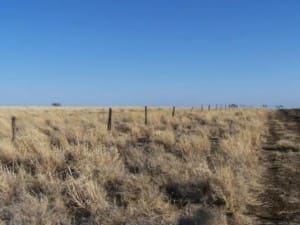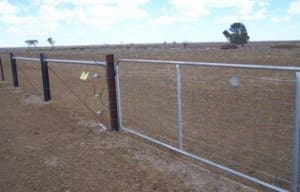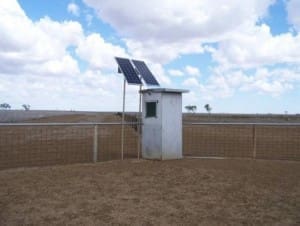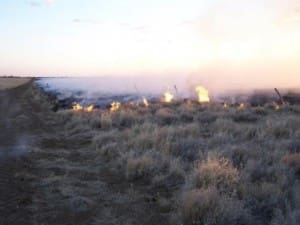The following case study was produced by the Leading Sheep program in Queensland:
John and Penny Taylor, Accord, Longreach
- John and Penny Taylor replaced 11.4km (25pc) boundary fence with electric fencing.
- The fence has reduced pasture pressure from kangaroos, predators and their neighbour’s cattle.
- The fence has been an effective barrier for wild dogs but the Taylors have continued their wild dog control program.
- There are plans to extend the electric fencing to other sections of the property boundary.
Background
In November 2013, John and Penny Taylor renewed 11.4km of their western boundary on ‘Accord;, Longreach, with an electric fence, covering 25 per cent of their boundary.
The existing boundary fence was in a serious state of disrepair and they had a new neighbour who was keen to assist with upgrading the boundary.
Renewing this section of fencing impacted upon approximately 60 per cent of their sheep flock.
The key drivers for erecting the electric fencing were to put a stop to wild dogs, kangaroos and their neighbour’s cattle entering the property.
“The first signs of wild dog activity started on our property about 18 months ago, so we wanted to be pro-active rather than reactive. Due to the poor state of the boundary fence we also had trouble with our neighbour’s cattle entering Accord,” Mr Taylor said.
“We strongly believe to remain viable in the grazing industry we have to exclude kangaroos and wild dogs from within our property boundary. With the new macropod harvesting rules and the increased
number of wild dogs, every grazier will have to adopt some form of exclusion fencing to survive.
“There is a lot of discussion going on amongst sheep producers south of Longreach who are interested in exclusion fencing, and we are happy to share notes about our fence with Leading Sheep participants.”
Fence design
The electric fence design is six plain wires (alternating – three earth and three live wires) with a barb on top. The total height is 1200mm. A seven-foot (2.1 metre) star picket was used every 10m, with a
Weston poly dropper used as an insulator, every five metres. There is a three-inch (7.5cm) steel strainer as well as an earth stake approximately every kilometre, which coincides with gateways and corner assemblies.
The existing boundary fence was in a serious state of disrepair.
The Taylors installed a single Gallagher 2800i Solar Energiser, which is located at the centre of the fence line. They considered a mains powered energiser, but chose the solar energizer due to the
distance from the mains power, as well as the cost of electricity.
“We have observed that kangaroos are not hitting the fence and have elected to travel beside the fence rather than try and find a way through it. There are also pads from the neighbour’s cattle on their side of the fence only,” Mr Taylor said.
Costs
The fence cost approximately $4300 per kilometre to install. This price is exclusive of John and Penny’s labour, as well as the time and money spent on preparing the fence line.
- Electric fence materials (energiser, insulators, earth stakes etc.) – $10,575
- Standard fence materials (barb, plain wire, steel pickets etc.) – $18,212
- Contract labour – $19 908
- Total costs – $48 695
Approximately six days were spent preparing the line, which included pushing up and burying the old fence and grading a 10m wide fence line.
“There was a second old boundary fence beside the existing boundary, on the neighbour’s side, which meant there were large amounts of old wire lying in the grass,” Mr Taylor said.
“It was important to clear all the old wire as kangaroos and livestock can short out the electric fence by kicking loose bits of wire into it.”
A 30- 15 metre wide strip was also burnt on each side of the boundary as a fire break, because the Weston poly droppers can burn in a fire.
“We are grateful to our neighbour who contributed to the cost and transport of the fence materials as well as providing machinery to assist with the preparation of the fence line,” Mr Taylor said.
“The thorough preparation has been worth it because it has kept the cost and time spent with periodic maintenance to a minimum. About one hour a month.”
The single Gallagher 2800i Solar Energiser is located at the centre of the fence line.
The electric fence design is six plain wires with a barb on top.
Ongoing costs
- There will be ongoing costs for spraying the fence line and maintaining batteries. Grass and weeds can short out the fence, but they will only have to be controlled after big rain events. Electric current will limit the amount of grass that grows along the fence line in future years.
- Costs for spraying the fence line for weeds include labour and chemical (Roundup) – the estimated total cost is approximately $400 per application and will be required once per year if there has been above average summer rainfall.
- Costs for treating emerging mimosa to prevent them shorting out the fence include two hours labour plus chemical (Access) and diesel. The estimated total cost is approximately $200 per application.
- There are three deep cycle batteries capable of energising the fence during overcast periods. The expected life of the batteries is five years. The current replacement cost is $200 per battery.
- The Energiser has an expected life span of 15-20 years – current cost $1700.
- Checking the electric fence is incorporated with water and feed runs. It takes one minute to check the read out on the Energiser’s display panel, once a week.
Was it good for business?
Key benefits of the electric fence have been:
- Reduced pasture pressure from kangaroos and neighbour’s cattle. This benefit will increase dramatically when the entire property is completely enclosed with exclusion fencing.
- Time saved collecting stock from the neighbour’s property.
- The knowledge that stock are benefitting from the pasture that the kangaroos and neighbour’s cattle would normally be eating.
- If woody weeds (eg prickly acacia) become a problem in the future, we are able to control the type and number of animals that enter the property and that may aid in weed control.
- The fence can also help stop pigs, which are very destructive at lambing time.
Future plans
The success of the project and the information received from a subsequent Leading Sheep Feral Fencing bus tour has galvanised the Taylor’s commitment to continue replacing their boundary fence with some form of exclusion fencing, as soon as possible.
The next section of exclusion fencing planned will run parallel to the Barcaldine – Longreach railway line. The Taylors will utilise a conventional exclusion fence for this section due to its close proximity
to where public contractors work, and the uneven terrain.
“We may decide to run an electric wire close to the ground as an extra deterrent for wild dogs and kangaroos trying to get through, but that will be on our side of the fence, to keep it away from public
contractors.
“Our electric fence energiser has remote monitoring capabilities but we have yet to incorporate these technologies into our management,” Mr Taylor said.
Conclusion
The Taylors believe that incorporating a length of electric fence along the boundary has been very successful.
“It is to be noted that we commenced wild dog control well before erecting our electric fence and this will continue,” Mr Taylor said.
“We participate in coordinated baiting campaigns, plus additional ground baiting and always carry a rifle in case we sight a wild dog that has entered the
property from the section of our boundary fence that has yet to be renewed with exclusion fencing.
“This fence gives us peace of mind with this part of the property and we are pleased to have completed
stage one of our boundary predator fence. We now have less stress and sleep better at night.
“Our electric fence can be seen by anyone travelling along the Landsborough Highway so it has definitely stimulated discussion and comment from a wide range of people. We are sure it will
continue to encourage graziers within the region to incorporate some form of exclusion fencing on their properties,” he said.
Top Tips
- Electric fencing is adaptable to varying land types. Even with just one or two electric wires the fence will give you some form of protection.
- Negotiating with neighbours can be a difficult area when you wish to install exclusion fencing along a boundary, especially if the neighbour does not wish to invest in the
- establishment of a fence to control predators. It is very important to communicate effectively to avoid any misunderstanding.
- Thorough preparation of the fence line will save you time in the long term.




